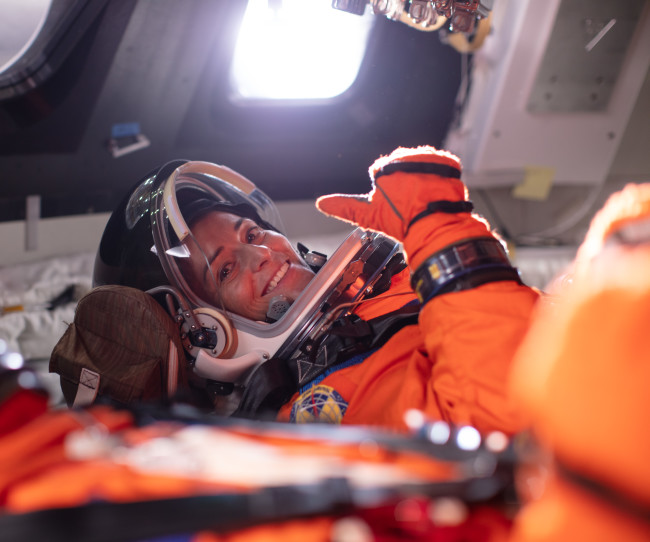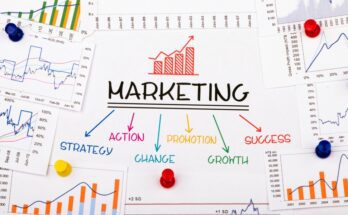At a time of social unrest and a still-unfolding global pandemic, NASA has delivered a welcome bit of purely positive news. Yesterday’s launch of SpaceX’s Crew Dragon capsule went off flawlessly, lofting astronauts Douglas Hurley and Robert Behnken to the International Space Station. For the first time since 2011, the U.S. is launching humans into space on its own. And for the first time ever, astronauts have traveled into space aboard a privately developed craft.
These developments carry special import to astronaut Catherine “Cady” Coleman. She has flown into space three times and supervised more than 100 experiments aboard the space station. Even more to the point, she was the lead astronaut overseeing the first commercial supply ships to the station; before retiring from NASA in 2016, she continued to develop public-private partnerships for the agency’s office of the chief technologist. She was an early advocate of expanding the role of private companies within NASA, and the Crew Dragon launch is the most dramatic example yet of the success of those efforts.
Not that Coleman is one to brag. Like most astronauts I’ve spoken to, she is meticulous about framing her role within a grand, collaborative effort. Still, she was also undeniably thrilled about this latest launch. I spoke with Coleman about Crew Dragon and about where public-private space efforts could take us. A lightly edited transcript of our conversation follows.
Beyond the obvious significance of the launch of astronauts from the U.S. after such a long gap, what does this Crew Dragon launch mean to you?
I’m somebody who really believes in exploration. It’s something you never stop being a part of. To me, this mission represents so many more possibilities for exploration. I don’t just mean that it’s a SpaceX launch, but the fact that we have a commercial crew program and this is the first in the season of test flights. We’re doing this together, something that seems so hard — working together when you have such different cultures.
Are you jealous at all that you don’t get to be one of the astronauts on this flight?
In general, yes, but not for this particular mission. It’s not like, “Oh it’s so dangerous and I don’t want to go!” This is a mission that requires people with past experience. If they had a third person on the mission, I’d love to be that third person.
There’s a lot of facilitating and integration that has to be done, especially when you have two giant families that are trying to integrate, SpaceX and NASA. That’s something I did a lot of work with when I was at NASA. I was in charge of supply ships for the astronaut office, during the time when we were trying to integrate SpaceX and Orbital Sciences and the Japanese into that. I was the second person ever to capture a [private] supply ship; Nicole Stott was the first.
That’s also the role I play in a crew: I figure out who everybody is and what kind of help they need, and help them solve problems together, or realize what each other’s strengths are. So I’d love to be person No. 3 this mission.

The other private space capsule: Boeing’s CST-100 Starliner had a rocky unpiloted test last December, but could soon be flying with a crew. (Credit: NASA/Cory Huston)
You’d also just like to try out the new Crew Dragon space capsule and see what it’s like, right?
It’s important to realize it’s not just SpaceX and Crew Dragon, it’s the commercial crew program and there are two vendors. The Boeing capsule [Starliner] is also going to be a very exciting test mission. The test pilot on that mission is Nicole Mann, who I think is fascinating and smart and really great to work with.
But in terms of all the other missions: Yes, I’m incredibly jealous! I always want to go. I would go in a minute, especially now that my kid’s in college.
You’ve helped cultivate commercial partnerships with NASA. What do you expect to see now that we’ve reached the point of private companies ferrying astronauts to the International Space Station?
It’s amazing how much we’ve increased our capabilities. We’ve got another place to launch from, and it’s a really powerful place. The U.S. has such a history of spaceflight, and being able to control more of the parameters — it’s going to add so many more possibilities in terms of the kind of work we can do in space. Whether it’s an experiment or new spacesuit or an environmental system, these are all steps on the road to going farther.
The government can’t and shouldn’t be doing this all by themselves. We’ve figured out, over a long history, how to get people and stuff up to low Earth orbit. Not that it’s ever easy, but it’s a pretty well-defined problem now. Now we can say, “Here’s the definition of what we need and here, you companies that have more access to innovative ways can find the best way to do it.”
NASA is part of the government and is responsible to the taxpayers, and is very cognizant of that. By definition, they have to take steps that are more careful and easily explained as prudent. That’s not the way to leap ahead in spaceflight. Our commercial partners can take bigger risks with hardware. Not when there are people aboard, but with hardware. That brings all of us many steps ahead.
The space shuttle was supposed to be the future of spaceflight, but now we’re back to capsules. Was the shuttle program a detour in spacecraft development?
In these early days, I don’t think any big step is a detour. Look what we learned from the shuttle. We had a payload bay, which was great for cargo even though we didn’t always need it for cargo. There are things we learned about flying a vehicle of that size and shape, and about how to bring it home safely, that are then going be applicable when we are trying to bring more people into space at one time.
If you look further, in terms of what the benefits of the space shuttle were: We could bring so many people into space, and so many different kinds of people, and that meant that kids all around the country and all around the world could look at a poster of space shuttle astronauts, not just from the U.S., and think, “Oh, that could be me.” I think that’s a powerful accomplishment of the space shuttle.
It’s something I’m a little concerned about with this launch.
You mean, this current launch makes space seem a little less accessible than before?
When we showed those astronauts walking out to the launchpad, it worries me that it’s not a picture that everybody can see themselves in. I think about that as someone who grew up in the 1960s. Even though I grew up in an exploration-based family — my dad was a deep-sea-diving explorer — it never occurred to me that I could be one of those people. When I looked at the picture of the Mercury 7, nothing in that picture said, “This could be you.”
I admire what everyone is doing to make sure that a balanced picture of the whole [spaceflight] program comes through. I’ve been working with ABC, National Geographic and Hulu — they’ve made a concerted effort to make sure people realize this program is made up of a lot more than the two people who walked onto the launchpad. To be clear, though, they’re great guys. And they’re the right guys for this mission.

NASA astronaut Nicole Mann is assigned to the first flight of Boeing’s Starliner; here she is trying out a mockup of the larger Orion capsule that will head to the moon. (Credit: NASA/Bill Ingalls)
Where do you see NASA going from here? In your view, what should come next in human spaceflight?
It sounds kind of mundane, but I’d like to see us maximize what we can do on the space station for as long as we can do that, because there’s a lot left to learn in low Earth orbit. The moon is a good next destination. Mars is ultimately the destination, but there’s still a lot of stuff to figure out. There are things you can try out in low Earth orbit, but you’re not dealing with lunar dust, which might give you an idea of how to handle martian dust. So there are things you’re better off trying out on the moon, and there are things you’re just not going to know until you get to Mars.
When we go to Mars — with the way we’re planning to travel and the kind of propulsion we’ve got — it’s just not going to happen very often. That means you need to get it right, people need to start making preparations about what to bring.
I hope that the future is filled with a fail-and-fail-often approach. Let’s bring a lot of experiments into the laboratories — the space station and the moon — and find things out, instead of doing things where we’re already pretty sure of the answer.
Beyond the changing technology, how do you see the culture of space travel changing?
Traditionally in the space program, there’s been this culture that it’s all about the work, and sharing is extra, only if you have time. To some extent, that’s how it has to be. Back in those days, it was not condoned if I’d show pictures of my family when I went out to talk. That was really important to me, because I wanted other people to know that someone with dimensions just like them could do the job. Which meant that could be them, too.
With this launch, I’m just thrilled by NASA’s “Bob and Doug” videos. They let you feel like, “Oh, those are real people!” It’s great that NASA is doing that kind of thing. Bob and Doug are married to marvelous women who are both astronauts — exceptional astronauts in their own right. It’s that dimension, that people don’t do these things alone.
I don’t mean that everyone has to have a husband or a wife and kids. Family is your community. Showing that these are real people doing these things, and sharing more about them, allows more people to feel like, “this could be me.” And that’s actually how we’ll go to Mars.
Do you think that there is a human destiny to explore space?
I do! I used to think there were two places: There’s Earth, and there is space, two different places. Then I got up to orbit and I realized that home, our Earth, is just a lot bigger than we thought.
When you think about people crossing North America back in the days of Lewis and Clark, they didn’t know what they would find. Now it’s just a place where we think, “Oh, this is our country.” Just because we haven’t been somewhere yet doesn’t mean it’s not a place where we all belong.
What will you be watching for at the end of this mission, when the Crew Dragon returns to Earth? That will be another milestone, the end of the first commercial human spaceflight.
When I’m watching, I’m seeing the whole spectrum. When Bob and Doug got out of their cool cars (and I have a Tesla as well), they were walking through the same doorway that Mercury, Gemini, Apollo and shuttle astronauts, including myself, have walked through. It’s like this continuum.
It doesn’t matter so much what vehicle is leaving from the launchpad. It’s about the people who are doing that, the team, the astronauts. It’s the crew of exploration — it might be different people, but it’s still the crew of exploration, if that makes sense. So I look for that kind of continuity: Oh, that’s the same; oh, that’s different; that’s new; that’s so cool. I wonder how many other people will do what they just did.
For more science news and big ideas, follow me on Twitter: @coreyspowell


